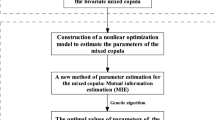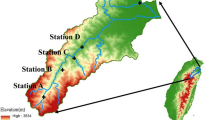Abstract
Multivariate hydrological frequency analysis is important when designing hydraulic and civil infrastructures. However, hydrologic data scarcity and insufficiency are common. By studying the relationship between copula entropy and total correlation estimated by the matrix-based Renyi's α-order entropy functional, a new estimation method (total correlation estimation, TCE) for parameters of the Gumbel-Hougaard copula and Clayton copula was proposed when the sample size was equal to or less than 30. A total of 11,802 simulations were performed to evaluate the performance of TCE for sample sizes ranging from 30 to 5, and were compared with traditional estimation methods that require a large amount of data. As for the Gumbel-Hougaard copula, the performance of TCE is satisfactory regardless of sample size, while the traditional methods perform poorly when the sample size is equal to or less than 20. For the Clayton copula, TCE is reliable and robust and performs well if the sample size is greater than 10, while the traditional methods are unreliable when the sample size is less than 25. Also, TCE is applied to construct the joint distributions of annual runoff and sediment discharge in the Xiliugou River, China. The method based on Renyi's α-order entropy functional provides a new way for multivariate hydrological frequency analysis with small sample sizes.






Similar content being viewed by others

Availability of Data and Material
Available from corresponding author on request.
References
Bernaola-Galván P, Ivanov PC, Amaral LAN, Stanley HE (2001) Scale invariance in the nonstationarity of human heart rate. Phys Rev Lett 87:168105
Boomsma A (1983) On the robustness of LISREL (maximum likelihood estimation) against small sample size and non-normality. J Am Stat Assoc 179(386)
Chen L, Guo S (2019) Copula-based flood frequency analysis. In Copulas and Its Application in Hydrology and Water Resources. Springer Water. Springer, Singapore
Chen L, Singh VP, Guo S (2013) Measure of correlation between river flows using the copula-entropy method. J Hydrol Eng 18:1591–1606
Chen L, Singh VP, Huang KD (2018) Bayesian technique for the selection of probability distributions for frequency analyses of hydrometeorological extremes. Entropy 20(2):117
Das J, Jha S, Goyal MK (2020) Non-stationary and copula-based approach to assess the draught characteristics encompassing climate indices over the Himalayan states in India. J Hydrol 580:124356
De Michele C, Salvadori G, Vezzoli R, Pecora S (2013) Multivariate assessment of droughts: frequency analysis and dynamic return period. Water Resour Res 49:6985–6994
Devkota S, Shakya NM, Sudmeier-Rieux K, Jaboyedoff M, Westen CJ, Mcadoo BG, Adhikari A (2018) Development of monsoonal rainfall intensity-duration-frequency (IDF) relationship and empirical model for data-scarce situations: the case of the Central-Western Hills (Panchase Region) of Nepal. Hydrology 5:27
Favre AC, El Adlouni S, Perreault L et al (2004) Multivariate hydrological frequency analysis using copulas. Water Resour Res 40:W01101
Fawad M, Yan T, Chen L, Huang KD, Singh VP (2019) Multiparameter probability distributions for at-site frequency analysis of annual maximum wind speed with L-moments for parameter estimation. Energy 181:724–737
Frahm G, Junker M, Schmidt R (2005) Estimating the tail dependence coefficient: properties and pitfalls. Insur Math Econ 37(1):80–100
Ghosh S, Westen CJ, Carranza EJM, Jetten VG, Cardinali M, Rossi M, Guzzetti F (2012) Generating event-based landslide maps in a data-scarce Himalayan environment for estimating temporal and magnitude probabilities. Eng Geol 128:49–62
Jaiswal RK, Lohani AK, Tiwari HL (2015) Statistical analysis for change detection and trend assessment in climatological parameters. Environ Process 2:729–749
Hou B, Jiang C, Sun OJ (2020) Differential changes in precipitation and runoff discharge during 1958–2017 in the headwater region of Yellow River of China. J Geogr Sci 30:1401–1418
Huang S, Chang J, Huang Q, Chen Y (2015) Identification of abrupt changes of the relationship between rainfall and runoff in the Wei River Basin, China. Theor Appl Climatol 120(1–2):299–310
Latif S, Mustafa F (2021) Bivariate flood distribution analysis under parametric copula framework: a case study for Kelantan River basin in Malaysia. Acta Geophys 68:821–859
Li H, Wang D, Singh VP, Wang Y, Wu J, Wu J, Liu J, Zou Y, He R, Zhang J (2019) Non-stationary frequency analysis of annual extreme rainfall volume and intensity using Archimedean copulas: a case study in eastern China. J Hydrol 571:114–131
Liu T, Huang H, Shao M, Liu G, Yang Y (2015) Impacts of climate and human activity on process of water and sediment load along Yellow River in Erdos. J Soil Water Conserv 29(5):17–22 (in Chinese)
Liu X (2016) Causes of sharp decrease of water and sediment in the Yellow River in recent years. Science Press, Beijing
Mohanty MP, Sherly MA, Karmakar S, Ghosh S (2018) Regionalized design rainfall estimation: an appraisal of inundation mapping for flood management under data-scarce situations. Water Resour Manag 32:4725–4746
Pandey PK, Das L, Jhajharia D et al (2018) Modelling of interdependence between rainfall and temperature using copula. Model Earth Syst Environ 4:867–879
Qian L, Wang H, Dang S, Jiao Z, Zhao Y (2018) Modelling bivariate extreme precipitation distribution for data scarce regions using Gumbel-Hougaard copula with maximum entropy estimation. Hydrol Process 32:212–227
Qian L, Dang S, Bai C, Wang H (2021) Variation in the dependence structure between runoff and sediment discharge using an improved copula. Theor Appl Climatol 145:285–293
Renyi A (1961) On measure of entropy and information. Proc 4th Berkeley Symp Math Statist Prob 1:547–561
Sanchez Giraldo LG, Rao M, Principe JC (2015) Measures of entropy from data using infinitely divisible kernels. IEEE Trans Inf Theor 61(1):535–548
Shi J, Malik J (2000) Normalized cuts and image segmentation. IEEE Trans Pattern Anal Mach Intell 22(8):889–905
Singh VP, Zhang L (2018) Copula–entropy theory for multivariate stochastic modeling in water engineering. Geosci Lett 5:6
Tian S, Xu M, Jiang E, Wang G, Hu H, Liu X (2019) Temporal variations of runoff and sediment load in the upper Yellow River, China. J Hydrol 568:46–56
Tsakiris G, Kordalis N, Tsakiris V (2015) Flood double frequency analysis: 2D-Archimedean copulas vs bivariate probability distributions. Environ Process 2:705–716
Wang WJ (2001) A Bayesian joint probability approach for flood record augmentation. Water Resour Res 37:1707–1712
Xiong L, Jiang C, Xu CY, Yu K, Guo S (2015) A framework of change-point detection for multivariate hydrological series. Water Resour Res 51(10):8198–8217
Yang Y, Li Z, Li P, Ren Z, Gao H, Wang T, Xu G, Yu K, Shi P, Tang S (2017) Variations in runoff and sediment in watersheds in loess regions with different geomorphologies and their response to landscape patterns. Environ Earth Sci 76(15):517
Yu S, Giraldo LGS, Jenssen R, Principe JC (2019) Multivariate extension of matrix-based Renyi's alpha-order entropy functional. IEEE Trans Pattern Anal Mach Intell PP(99):1–1
Zening W, Chentao H, Wang H, Zhang Q (2020) Reservoir inflow synchronization analysis for four reservoirs on a mainstream and its tributaries in flood season based on a multivariate copula model. Water Resour Manag 34:2753–2770
Zhong M, Zeng T, Jiang T et al (2021) A copula-based multivariate probability analysis for flash flood risk under the compound effect of soil moisture and rainfall. Water Resour Manag 35:83–98
Funding
The study was supported by the National Science Foundation for Distinguished Young Scholars of China (Grant No. 52025093), the Open Research Fund of State Key Laboratory of Simulation and Regulation of Water Cycle in River Basin, China Institute of Water Resources and Hydropower Research, Grant NO. IWHR-SKL-KF202009, National Natural Science Foundation of China (Grant Nos. 51609254 and 41875061), and NUPTSF (Grant Nos. NY219161 and NY220035).
Author information
Authors and Affiliations
Contributions
The contribution of Longxia Qian is project design, model construction and case study. The contribution of Yong Zhao includes project design and result analysis. The contribution of Jianhong Yang is algorithmic programming. The contribution of Hanlin Li is model validation. The contribution of Chengzu Bai is model comparison.
Corresponding author
Ethics declarations
Ethics Approval
The authors confirm that this article is original research and has not been published or presented previously in any journal or conference in any language (in whole or in part).
Consent to Participate and Consent to Publish
The authors declare that have consent to participate and consent to publish.
Competing Interests
The authors have no conflict of interest and are completely satisfied with the publication of their article in water resources management journal.
Additional information
Publisher's Note
Springer Nature remains neutral with regard to jurisdictional claims in published maps and institutional affiliations.
Rights and permissions
About this article
Cite this article
Qian, L., Zhao, Y., Yang, J. et al. A New Estimation Method for Copula Parameters for Multivariate Hydrological Frequency Analysis With Small Sample Sizes. Water Resour Manage 36, 1141–1157 (2022). https://doi.org/10.1007/s11269-021-03016-w
Received:
Accepted:
Published:
Issue Date:
DOI: https://doi.org/10.1007/s11269-021-03016-w



